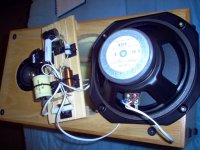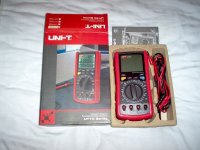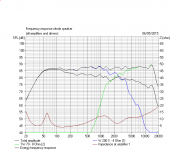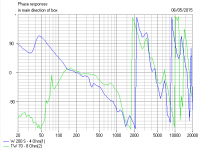Inductors aren't hard to find, though TBH you might wait a couple of weeks with Wilmslow:
Inductors
Theoretically, solid baked air cored will sound better than ferrites. The simple maths of it says that ferrite cores increase inductance about fourfold for a given resistance. So a 0.3mH air core will have the same 0.3R resistance as a 1.2mH ferrite. You'd need PA levels of sound to seriously stress these components. They're not going to even get warm!
It's quite easy to unwind a coil to reduce inductance. Inductance is the square of the number of turns. So you take off about a quarter of the windings to halve inductance, then scrape off the enamel with a stanley knife for good soldering. I usually check with a £70 Maplin inductance-scale multimeter as I go along.
Below is a wilmslow loosely wound 0.2mH aircoil and a 1mH ferrite on the bass section. And my useful top-grade multimeter. 😀
Inductors
Theoretically, solid baked air cored will sound better than ferrites. The simple maths of it says that ferrite cores increase inductance about fourfold for a given resistance. So a 0.3mH air core will have the same 0.3R resistance as a 1.2mH ferrite. You'd need PA levels of sound to seriously stress these components. They're not going to even get warm!
It's quite easy to unwind a coil to reduce inductance. Inductance is the square of the number of turns. So you take off about a quarter of the windings to halve inductance, then scrape off the enamel with a stanley knife for good soldering. I usually check with a £70 Maplin inductance-scale multimeter as I go along.
Below is a wilmslow loosely wound 0.2mH aircoil and a 1mH ferrite on the bass section. And my useful top-grade multimeter. 😀
Attachments
Last edited:
My original idea was a 2 way crossed at about 1.6k with an RS28F or A but they wont be in stock for months and 3 ways are just too expensive for a 7 channel setup so now I dont know what to do!
I suggest to do a very decent sounding 2 way speaker with enough
capability to play lower midbass like the one presented here
in post #2568:
http://www.diyaudio.com/forums/multi-way/23208-system-pictures-description-257.html
capability to play lower midbass like the one presented here
in post #2568:
http://www.diyaudio.com/forums/multi-way/23208-system-pictures-description-257.html
RS28A: RS28A-4 Dayton - Audiokit E-Shop
RS28F: RS28F-4 - Dayton 1-1/8 inch Silk Dome Tweeter 4 Ohm - Europe Audio
You can find there also coils, caps, resistors, and all things needed to build speakers.
I've bought from both shops in the past so I offer some advice: on Europe Audio buy only what they have at stock, period. With Audiokit feel free to ask before because they don't show what they have at stock, but they are very friendly and reliable.
Ralf
PS do you know that UK is part of EU, meaning no import fees from other EU countries 🙂
RS28F: RS28F-4 - Dayton 1-1/8 inch Silk Dome Tweeter 4 Ohm - Europe Audio
You can find there also coils, caps, resistors, and all things needed to build speakers.
I've bought from both shops in the past so I offer some advice: on Europe Audio buy only what they have at stock, period. With Audiokit feel free to ask before because they don't show what they have at stock, but they are very friendly and reliable.
Ralf
PS do you know that UK is part of EU, meaning no import fees from other EU countries 🙂
giralfino, I thought we won the war and stayed out of the German EU! 😀
Nevertheless along with the Panzer Tank, I think the Germans do a good loudspeaker designer software: Downloads.
8" bass and tweeter is my own particular hobby:
30 litre closed or reflex box and some suitable crossover and you have a fine system. The above one uses a W 200 S - 4 Ohm and a TW 70 - 8 Ohm. I haven't built it yet, but it all looks OK.
I'd be wary of a metal bass cone like this typical SEAS Excel unit: E0022-08S W22EX001
Some complexity there. That 5kHz peak could be troublesome.
Nevertheless along with the Panzer Tank, I think the Germans do a good loudspeaker designer software: Downloads.
8" bass and tweeter is my own particular hobby:
An externally hosted image should be here but it was not working when we last tested it.
30 litre closed or reflex box and some suitable crossover and you have a fine system. The above one uses a W 200 S - 4 Ohm and a TW 70 - 8 Ohm. I haven't built it yet, but it all looks OK.
I'd be wary of a metal bass cone like this typical SEAS Excel unit: E0022-08S W22EX001
Some complexity there. That 5kHz peak could be troublesome.
Attachments
giralfino, I thought we won the war and stayed out of the German EU! 😀
You are lucky enough it's not allowed to discuss politics here.😉
The superior high frequency polar response of a 0.75" dome tweeter is considered a valuable benefit of using a 2" dome midrange.
These drivers look good together if you are still open to change ... ND20FB 3/4" fabric dome + Dayton RS52AN-8 dome + paper cone Dayton RS225P-8 woofer
Dayton RS52AN-8 2" Al-dome to ND20FB 3/4" fabric dome based upon Zaph's ZDT3.5 .... (start with Zaph's TM Xover)
AND the higher SPL + smoother response of the paper cone Dayton RS225P-8 woofer
The paper cone Dayton RS225P-8 woofer has SPL=90.2db, and slightly higher Fs=32Hz than Al-cone version.
The Al cone Dayton RS225-8 woofer has SPL=86.2, but will have slightly lower bass extension from Fs=28Hz
These drivers look good together if you are still open to change ... ND20FB 3/4" fabric dome + Dayton RS52AN-8 dome + paper cone Dayton RS225P-8 woofer
Dayton RS52AN-8 2" Al-dome to ND20FB 3/4" fabric dome based upon Zaph's ZDT3.5 .... (start with Zaph's TM Xover)
AND the higher SPL + smoother response of the paper cone Dayton RS225P-8 woofer
The paper cone Dayton RS225P-8 woofer has SPL=90.2db, and slightly higher Fs=32Hz than Al-cone version.
The Al cone Dayton RS225-8 woofer has SPL=86.2, but will have slightly lower bass extension from Fs=28Hz
Can anyone suggest a tweeter that can be crossed low to suit the RS225 like the RS28F/A?
A large metal woofer is normally a poor choice for a 2 way because the clean operating range is not going to overlap the clean operating range of a 1" tweeter. The strong resonance of a metal driver tends to dictate a crossover point at less than a third of this frequency in order to avoid the third harmonic of the motor driving the resonance at highish SPLs. The resonance is typically around 4 kHz or so for an 8" metal woofer this suggests a steep crossover at perhaps 800 Hz or so plus notching out the resonance. The 1" RS28 is not able to do this reasonably you would need more of a 2" driver as was suggested earlier.
In order to run an 8" driver high successfully one tends to need a driver that has been designed to do this by using a softer cone that resonates less severely in a smooth manner. There are not many about with most 8" drivers being designed as woofers rather than midwoofers by the manufacturers.
Good points Andy. I use the B&C 8PE21 paper mid. It will go into kHz as easily as being a tapped sub horn driver.
The high frequency looks good but it will require a subwoofer for reasonable bass performance. Although not in the OPs price range, Volt make an 8" subwoofer, woofer and midwoofer which nicely illustrates the range of 8" driver that might be used as the low frequency driver in a speaker. One or two of the SEAS 8" drivers look reasonable for a 2 way but the Scan, Dayton, SB Acoustics look to be using fairly hard paper.Good points Andy. I use the B&C 8PE21 paper mid. It will go into kHz as easily as being a tapped sub horn driver.
Sorry, I forgot to make the point.. that paper pro drivers can be good for using right up to where they narrow and break-up.
BTW it's meant as a horn driver. It will do sub duty though, JLH has a design to show that.
BTW it's meant as a horn driver. It will do sub duty though, JLH has a design to show that.
The subs are 4x UM18's in an IB setup under a block and beam floor which is braced against a concrete base at the bottom of the pit which is a bit over 5000 liters.
The build is not finished yet so I've got several weeks.
I intend on crossing at 80Hz, I'm sticking with sealed speakers to simplify the design so I'm using 8" woofers so they are flat to the crossover frequency.
The build is not finished yet so I've got several weeks.
I intend on crossing at 80Hz, I'm sticking with sealed speakers to simplify the design so I'm using 8" woofers so they are flat to the crossover frequency.
Acording to the datasheets the paper cone has a lumpier response than the aluminium one just look at that dip just below 800Hz followed by a 7 dB rise, how can that be better?
Are you talking about the Dayton 8" paper cone? The rise is smooth and so relatively easy to equalise (smooth is important, flat less so) but it is a hard paper cone and the large resonance at 3.5 kHz is a problem.Acording to the datasheets the paper cone has a lumpier response than the aluminium one just look at that dip just below 800Hz followed by a 7 dB rise, how can that be better?
Now look at say the SEAS CA22RNY which is in your price range and designed for use in a 2 ways albeit ones that are ported. Big magnet, high efficiency, modest price. A 30 litre cabinet turned to about 45 Hz will give an F3 of about 55 Hz and a maximum SPL of 110 dB.
Could someone please trace the RS225-8 and RS28F-4 frequency and phase responses for me I cant find frd or zma files from the revised datasheets and I cant get any tracing software to work properly.
In the past I have used this for digitizing graphs having found the spltrace program too awkward.Could someone please trace the RS225-8 and RS28F-4 frequency and phase responses for me I cant find frd or zma files from the revised datasheets and I cant get any tracing software to work properly.
It is your project but I am curious about what you have seen that gives you confidence that crossing the Dayton 8" metal woofer to the 1" Dayton tweeter will work well given your original design understandably used a 2" upper midrange driver to help bridge the gap in the operating ranges? Do you intend to use a waveguide or a flat baffle for the tweeter? What crossover frequency 1kHz, 1.5kHz, 2kHz? How steep the slopes 4th, 8th? Notches? A successful design if it can be done is going to be pushing the limits.
Could someone please trace the RS225-8 and RS28F-4 frequency
and phase responses for me I cant find frd or zma files from the
revised datasheets and I cant get any tracing software to work properly.
I am willing to show you how to do tracing with SPL Tools (spl trace, spl view)
if that's okay with you. The phase calculation will be handled by a separate program
like Jeff's spreadsheet "Response Modeler 3.0" There you can include the baffle
step, diffraction, simulated box response and impedance.
- Status
- Not open for further replies.
- Home
- Loudspeakers
- Multi-Way
- Designing a 4th order 3 way passive crossover




